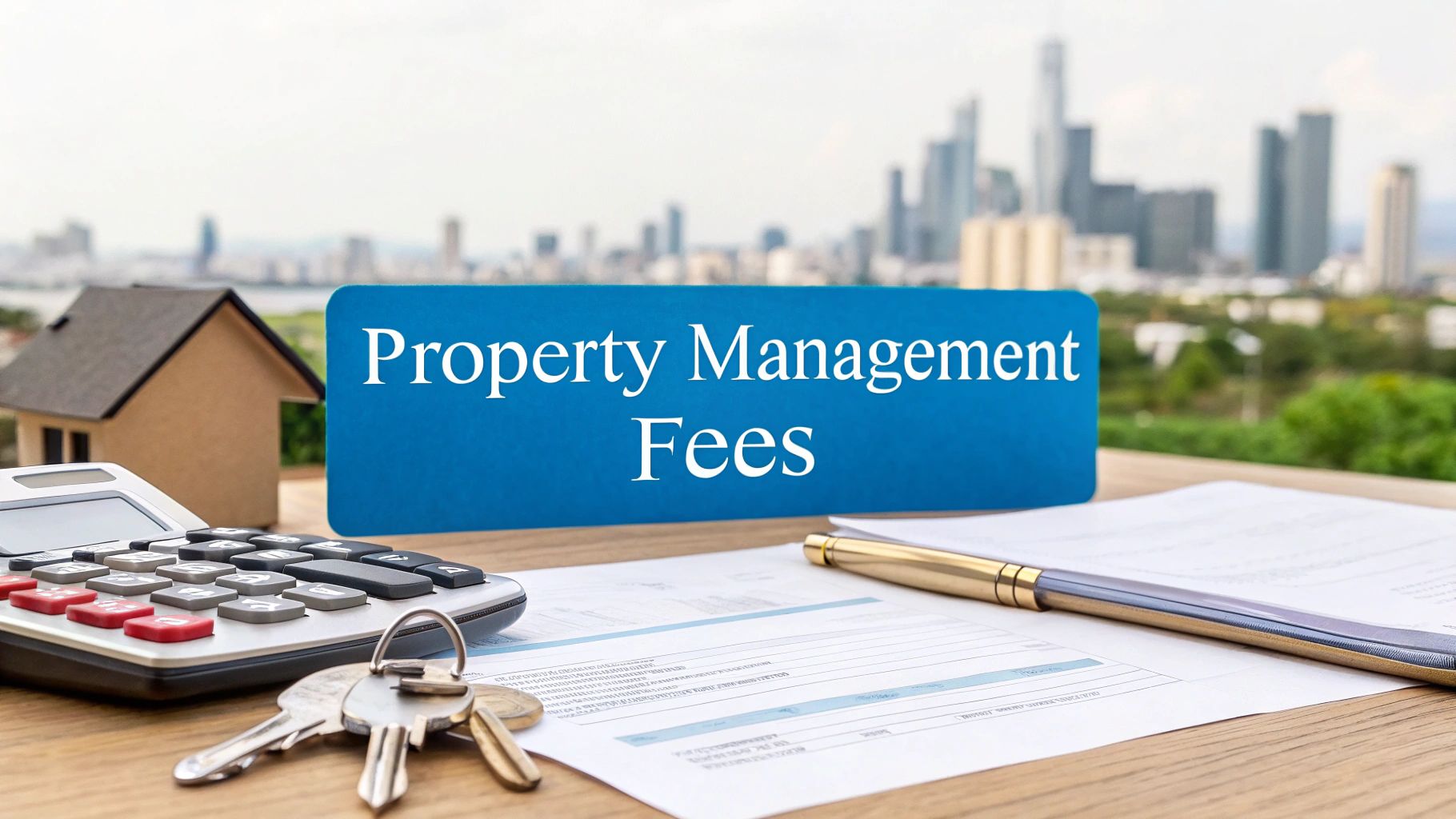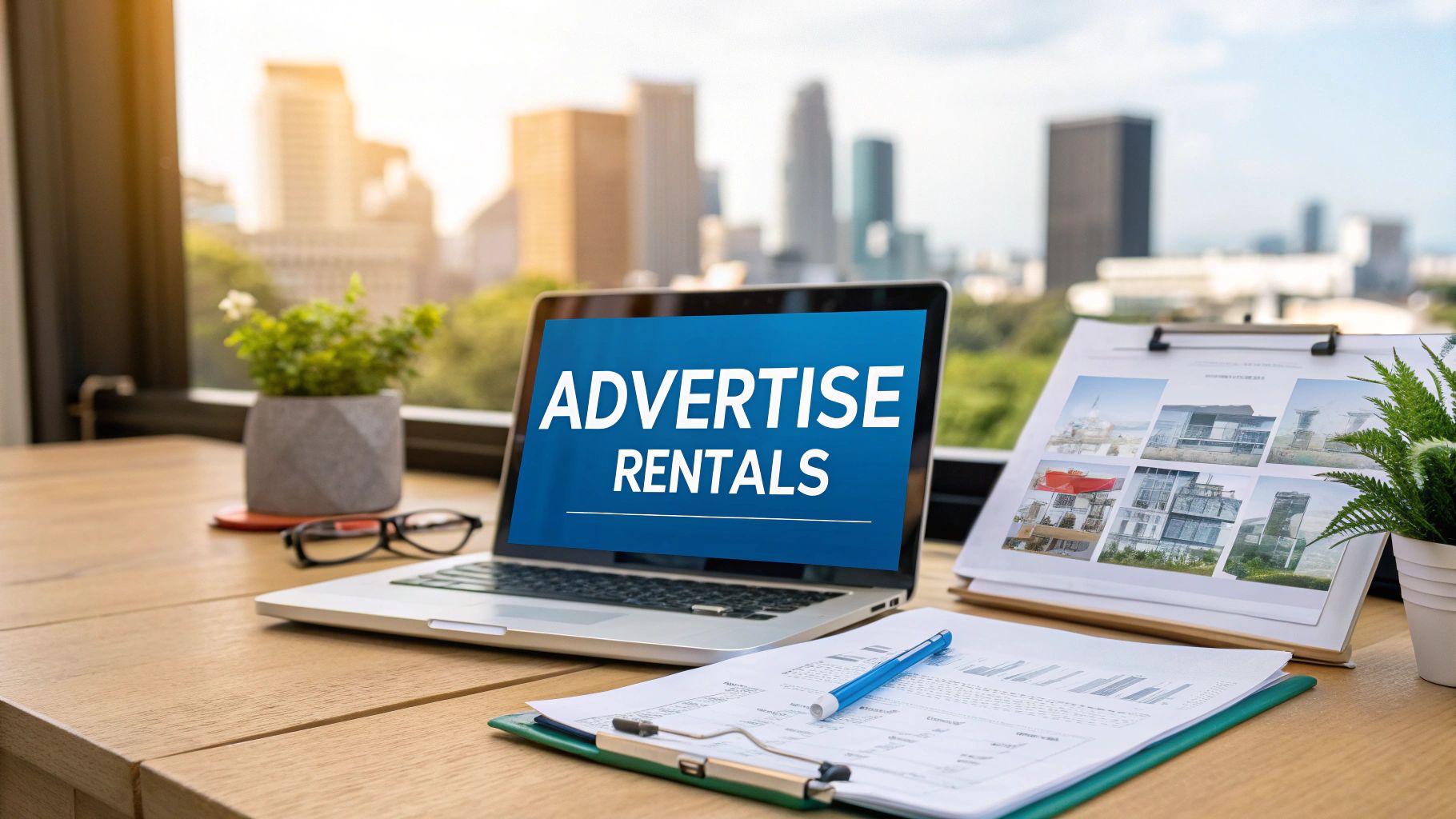When you're managing portfolios of 100, 1,000, or even 10,000+ units, the question "how much is a property management fee?" isn't answered with a simple number. For enterprise-level operators, the industry standard of 8-12% of collected rent is just the starting point for a much deeper conversation about operational efficiency and revenue impact.
What Is A Typical Property Management Fee
For large-scale operators, the base percentage means very little if operational inefficiencies lead to extended vacancies. The real test for any portfolio manager is understanding how the total cost of management directly impacts key performance metrics like Days on Market (DOM) and, ultimately, your Net Operating Income (NOI). Success isn't about securing the lowest percentage; it’s about partnering with a provider who can minimize revenue loss from vacancy.
When you're working at scale, you have a powerful negotiation tool: volume. The fee structure for a dense, 1,000-unit portfolio should look worlds apart from what a landlord with a few single-family homes is paying. This is where your leverage as a major operator kicks in, allowing you to secure rates that truly reflect the efficiencies you bring to the table. According to a 2024 analysis, the property management industry is highly competitive, meaning large portfolios can often negotiate rates significantly below the standard 8-12%.
Understanding Fee Variations By Property Type
The type of properties in your portfolio also plays a huge part in shaping the fee structure. Costs can vary widely based on the services needed, the complexity of day-to-day operations, and even the property's location.
For residential properties, those fees typically land somewhere between 8% and 12% of the monthly rent collected. On the other hand, commercial properties often see fees in the 4% to 12% range, which accounts for more intricate lease negotiations and tenant management demands. Getting a handle on these basic differences is the first step to building an accurate cost model for your entire portfolio. You can explore more details on property management cost structures to dig deeper.
This chart gives a quick visual breakdown of how average fees can shift across different property types.

As you can see, specialized assets like vacation rentals command much higher fees. That's no surprise, given their intensive, high-turnover management style.
Key Takeaway: For large-scale portfolios, the standard percentage fee is secondary. Your primary focus should be on the provider's ability to slash vacancy loss and improve key metrics like Days on Market (DOM) and lead-to-tour conversion. These factors have a far greater impact on your bottom line.
What's Really in That Standard Management Fee?
When you’re managing a large portfolio, that standard management fee is just the cost of doing business. But have you ever stopped to ask what that percentage actually buys your team? Getting a handle on what’s included is the first step to properly vetting proposals and spotting where extra charges might sneak in, bloating your total cost per door.

Think of this fee as the foundation of your partnership. It's supposed to cover the essential, day-to-day work required to keep your properties running smoothly.
What The Standard Fee Usually Covers
At its heart, the monthly management percentage pays for the core administrative and financial tasks that keep your occupied units running. While the exact details can differ from one company to the next, you should generally expect these services to be part of the standard package.
- Rent Collection and Processing: This is the big one. It covers all the systems for getting rent from tenants each month and making sure those payments are processed correctly.
- Basic Tenant Communications: This includes handling routine calls and emails from tenants—things like general questions or simple service requests that don't escalate into bigger maintenance or legal headaches.
- Financial Oversight and Reporting: You should expect to receive standard monthly owner statements. These reports give you a clear summary of the income and basic expenses for your portfolio.
- Lease Enforcement: This covers the small stuff, like addressing minor lease violations and sending out the necessary notices to keep tenants in line with their agreements.
Crucial Insight: The standard fee covers the management of occupied units, not the acquisition of new tenants. The activities that most impact revenue—leasing, showing, and marketing—are often where additional fees begin to surface, directly affecting your lead-to-tour conversion and speed-to-lease metrics.
For any operations director managing a distributed portfolio, establishing this baseline is non-negotiable. It creates a clear framework for figuring out how much you're really paying for the services that cut down on vacancy and actually drive revenue—which we’ll get into next. Drawing this line in the sand helps you avoid overpaying for services you don’t need and ensures every dollar you spend is pushing your portfolio's performance forward.
Uncovering Ancillary Fees That Inflate Your Cost Per Door
The base management percentage is just the beginning of the conversation. For large-scale portfolios, the real cost per door is often hiding in the ancillary fees—those à la carte charges that can quickly make a low base rate feel like a bait-and-switch.
As an operations director, you have to dig into these extra costs. They directly eat into your portfolio's profitability and can blow up your total management expenses by 20-30% or even more in the first year alone.

You absolutely need to understand these fees to build accurate financial models and avoid painful budget surprises down the road. A low headline rate means nothing if you're getting hammered by leasing and renewal fees every time a tenant moves out.
Common Ancillary Fees to Model
When you’re looking at a management proposal, your analysis has to go way beyond the base percentage to include every single potential charge. These fees often pop up around the very activities that drive your revenue—like leasing and tenant retention—which makes them critical points for negotiation.
Here are the most common fees that have a big impact on large portfolios:
- Leasing or Tenant Placement Fee: This is often the biggest ancillary cost you'll face. While a small-time landlord might pay a full month's rent, large portfolios should be negotiating for a much lower flat fee or a small percentage (think 25-50% of one month's rent). High leasing fees penalize you for turnover and can make a manager less motivated to improve lead-to-tour conversion rates.
- Lease Renewal Fee: Some managers charge a fee just to process a lease renewal with a tenant who is already in place. For enterprise-scale portfolios, this fee should be minimal or eliminated entirely, as tenant retention is far more profitable than turnover.
- Maintenance Coordination Markup: It’s common practice for managers to add a markup, often around 10-15%, to vendor invoices for maintenance and repairs. Across a 1,000+ unit portfolio, this can quietly snowball into a massive annual expense.
- Technology Platform Fee: Some management companies will pass on the costs of their property management software (PMS) or other tech tools as a separate per-unit-per-month line item. Be sure to clarify if this is included or extra.
These charges show why you need to look at the whole picture. The right partner will help you implement strategies to lease properties quicker and cheaper, making sure their success is tied directly to your main goal: reducing vacancy.
Portfolio Impact Analysis: A low base fee is often just a loss leader. The real money for the management company is made on these extra charges. Always request a complete fee schedule and model the total annual cost based on your portfolio's typical turnover and maintenance needs to understand the true cost per door.
Calculating the Total Cost of Management
Let’s actually model this out for a hypothetical 500-unit portfolio to see the real-world impact. This kind of exercise shows just how fast a fee that looks low can become totally uncompetitive once you factor in all the costs.
Hypothetical 500-Unit Portfolio Model
In this scenario, the ancillary fees tack on an extra $127,500 to the base management cost. That’s an increase of over 35%, elevating the effective management fee from 4% to approximately 5.4%.
This is exactly why operations directors have to push the conversation beyond the base percentage and build out comprehensive financial models during negotiations. This diligence is the only way to truly understand what a property management fee is going to cost your portfolio.
How Your Portfolio’s Size And Location Impact Fees
When you're operating at scale, a standard, off-the-shelf property management fee just won't cut it. The truth is, not all portfolios are created equal, and the fee you pay should reflect the unique reality of your assets. The two biggest factors that give you leverage in any negotiation are the scale of your portfolio and the geographic density of your properties.
Managing 1,000 units packed into a single metro area is operationally simpler than managing 1,000 units scattered across five states. When your properties are clustered together, maintenance routes become more efficient, showings can be scheduled back-to-back, and marketing efforts can be consolidated. All of that efficiency should absolutely translate into a lower per-door cost for you.
The Power of Economies of Scale
For operators with large portfolios, "economies of scale" isn't just a business school buzzword—it's your single most powerful negotiating tool. The U.S. property management market is a sprawling, competitive space, projected to hit nearly USD 98.88 billion by 2029. With over 304,000 property management businesses out there, many are hungry for large accounts. If you can demonstrate the operational efficiencies your portfolio offers, you're in a prime position to secure better rates.
Your negotiating power grows with every door you add. A manager overseeing a 500-unit portfolio has far more sway than one managing just 50. Why? Because the management company's fixed costs—things like software subscriptions, office space, and staff salaries—get spread across a much larger number of units. This directly lowers their cost-per-unit, and you should see a piece of that savings.
Critical Insight: Your portfolio's size and density aren't just operational perks; they're financial assets you bring to the bargaining table. Frame your conversations around the efficiencies your portfolio provides a management partner, and insist that those benefits are reflected in their fee structure.
How Property Class And Market Competition Affect Fees
Beyond just how many units you have and where they are, the type of property and the local competition also play a huge role in what you'll end up paying.
- Property Class (A, B, or C): Class A properties, with their high-end amenities and premium tenants, often command a lower percentage fee but demand a higher level of service. Conversely, Class C properties might come with a higher percentage fee to compensate for more intensive management, such as higher turnover and more frequent maintenance calls.
- Local Market Competition: If your portfolio is in a packed urban market swarming with management companies, the intense competition naturally drives prices down. But if your properties are in a more rural or less competitive area, you might face higher fees simply because there are fewer qualified managers to choose from.
Getting a handle on these variables is key for any operator trying to get their costs in line. When you benchmark your portfolio against these factors, you can walk into negotiations feeling confident and prepared. For operators looking to grow, developing smart property management growth strategies means actively seeking out markets where these factors work in your favor to create the best possible management cost structures.
Calculating the True Cost Impact on Revenue and ROI
If you're only looking at the management fee percentage, you're missing the bigger picture. The number that really matters isn't the fee itself, but the Total Cost of Management and how it eats into your portfolio's revenue and ROI. The real costs are hidden in the shadows of operational inefficiency.
For an enterprise portfolio, high Days on Market (DOM) and poor lead-to-tour conversion rates will drain your revenue far faster than any management fee. A "cheaper" manager who lets a unit sit vacant for an extra week just cost you more than the premium, tech-forward partner who filled it in days.
Shifting from Cost to Strategic Investment
The conversation has to change. Instead of asking, "what's the fee?" we need to be asking, "what's the net financial outcome?" A slightly higher management fee paid to a provider who uses technology like on-demand showing services and automation can significantly boost your Net Operating Income (NOI). How? By aggressively stamping out vacancy loss—the single largest controllable expense for most portfolios.
You have to see it as an investment in revenue optimization. The goal is to find a manager whose entire operational model is built to make you more money by getting qualified tenants into your units at top speed.
Case Study: The True Cost of Vacancy
Let’s run the numbers to see just how massive this impact can be. Picture a 1,000-unit portfolio with an average monthly rent of $1,800.
- Average Daily Rent: $1,800 / 30 days = $60 per day
- Daily Portfolio-Wide Vacancy Cost: $60/day/unit * 1,000 units = $60,000 per day (if every unit sat empty)
Now, let’s see what happens when a high-performance manager shaves just 10 days off the average DOM across the portfolio over one year.
Revenue Impact Calculation:
10 Days Saved x $60/day/unit = $600 in saved vacancy loss per turnover.
Assuming a conservative 30% annual turnover rate (300 units), the total revenue saved is:
300 Units x $600 = $180,000 in additional annual revenue.
That $180,000 completely changes the fee discussion, doesn't it? A management company that delivers these kinds of results might charge a higher percentage, but their net financial benefit to your bottom line is undeniable. Their skill in crushing DOM and converting leads translates directly into more cash in your pocket.
Beyond leasing, it's about looking at how every service contributes to efficiency. For example, setting up a system for efficient invoice management for real estate can tighten up back-office operations and boost ROI even further. This holistic view, which pairs leasing speed with operational smarts, is how you truly maximize returns. To get the full picture, it’s worth diving into these 8 ways to boost ROI for your portfolio. This is how you move from thinking about a simple fee to building a strategic partnership focused on optimizing every dollar.
Global And Regional Trends In Management Costs
If you're an operator with properties in multiple markets—or even multiple countries—knowing the going rate for a property manager in one city just isn't enough. You need to understand global cost benchmarks to expand strategically and perform solid due diligence before breaking into a new region. Applying a one-size-fits-all cost model to a diverse, international portfolio is a surefire way to miscalculate your finances.
The global property management market is ballooning, projected to hit around USD 27.8 billion by 2025. Europe is a huge piece of that pie, holding a market share of over 30%, which translates to about USD 8.07 billion. You can dig into the details of this global market growth to see the full picture.

While the US market is massive, this data shows that key European hubs like Germany (USD 1.6 billion) and the United Kingdom (USD 1.36 billion) are powerhouses in their own right. But it's important to remember that their cost models and day-to-day operational challenges are shaped by entirely different forces.
Comparing US and European Fee Structures
On the surface, fee structures might look similar between the US and Europe, but what drives those costs is often worlds apart. These differences create unique operating environments that directly impact your total cost of management.
- Regulatory Environments: European markets often have much stricter tenant protection laws. This can create a heavier administrative load—and higher costs—for things like evictions and compliance management, which often shows up as ancillary fees for legal processes.
- Market Maturity: In highly developed markets like the UK, the competition is intense, which can sometimes push down the base percentage fees. However, this is often balanced out by a complicated menu of extra charges for services that might be included as standard in the US.
- Economic Conditions: Local factors like labor costs and inflation rates have a direct line to operational expenses. Think maintenance coordination and staffing—these costs get passed through to you in the management fee structure.
Key Takeaway for Multi-Market Operators: Never assume that fee structures are portable from one country to another. You must conduct a deep dive into local regulations, market competition, and operational norms. It's the only way to plan your finances accurately and avoid making costly assumptions when you expand internationally.
Frequently Asked Questions
Is a Flat-Fee Property Management Model Better for Large Portfolios?
Not usually. While a flat fee might seem predictable, it often doesn't scale well and can misalign incentives. If a manager gets paid the same flat rate regardless of occupancy, what’s their real motivation to hustle and fill a vacancy quickly?
For large portfolios, you'll almost always get better financial results by negotiating a lower percentage-based fee that's tied to performance bonuses for metrics like reducing Days on Market (DOM) and improving lead-to-tour conversion rates. This structure ensures your management partner is just as focused on maximizing your revenue as you are.
How Can I Accurately Compare Management Proposals for My Portfolio?
You have to look past the headline percentage. Create a spreadsheet to model the "Total Cost of Management" for each proposal you receive. Itemize every single potential fee—leasing, lease renewals, maintenance markups, and technology fees.
Most importantly, model the financial impact of each firm's stated performance on vacancy loss. For instance, a provider that costs 1% more but consistently reduces your portfolio's average DOM by five days will almost always put more money back in your pocket. Quantify the revenue impact of their DOM reduction and speed-to-lease capabilities.
What Is a Reasonable Leasing Fee for a Large Multi-Family Portfolio?
If you're operating hundreds or thousands of units, paying a full month's rent as a leasing fee is a poor value proposition. That model is designed for small-scale landlords, not enterprise operators.
Your scale is your leverage. You should be negotiating for a much lower flat fee per unit or a significantly reduced percentage, typically in the 25-50% range of one month's rent. For example, a real-world negotiation for a 1,000-unit portfolio resulted in a flat $400 leasing fee per unit, saving the company over $500,000 annually compared to the "one month's rent" standard.
Ready to transform your leasing operations from a cost center into a revenue driver? Showdigs leverages on-demand showings and intelligent automation to slash your Days on Market and optimize your lead-to-tour conversion rates. Discover how our platform is purpose-built for property management at scale.







